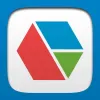Take a look inside 10 images
Pattern Shapes, by the Math Learning Center
Pros: A protractor, grids, and built-in patterns add extra learning potential to an otherwise excellent digital version of the classic manipulatives.
Cons: The app is very picky about rotating shapes before they snap together, and patterns can't go beyond the bounds of the screen.
Bottom Line: If you don't already have a bucket of pattern blocks, or you want a more portable option, this free version may be a great fit for your classroom.
You can easily use Pattern Shapes for exactly the same lessons that would normally require a big ol' bucket of wooden or plastic pattern blocks. But with the annotation tool, grids, and protractor, you can make those lessons richer with added points of inquiry. This will even work great for middle and high school students; they still love to mess around with pattern blocks, even if they're too cool to admit it.
If you've already got the physical version, some butcher paper, a few printout grids, and some protractors, there may not be any reason to switch to this app, aside from the convenience and a few extra tools. For floating teachers and mobile tutors, Pattern Shapes can ensure you're never without a full set of blocks.
Pattern Shapes is a drag-and-drop digital version of the classic elementary school mainstay, pattern blocks. This version emulates the colors of the originals exactly (but lets you change them up, if you want), and with a single tap users can add blocks to the board, drag to move, or grab pop-up handles to rotate. Dragging a path around groups of blocks selects them all, allowing users to duplicate the group or shrink blocks into smaller versions. Blocks snap together if they're rotated just right and dragged close enough to a compatible position.
To add some extra options for learning, Pattern Shapes includes a virtual protractor, a pen tool for annotating right on top of patterns, and an equation editor for formalizing relationships. There are also hex and square grids and some tangram-esque patterns for even more possibilities.
Since their introduction in the 1960s, pattern blocks have been a staple of constructivist education because they enable rich discovery learning, creativity, and mathematical inquiry in very young learners. While the tactile sensation of manipulating blocks is lost in Pattern Shapes, the extra features go a long way to make up for it. And since there's no possibility that someone could accidentally destroy a carefully built pattern, and groups of shapes can be duplicated to make tessellations, learning might actually happen a bit quicker with this virtual version.
There are a few headaches that could interfere with learning, most notably that shapes don't always snap together when they ought to and patterns can't extend beyond the screen bounds. Space is pretty limited, which can be frustrating, given the infinite supply of blocks. But, those limitations aside, this is a terrific tool for helping young learners experiment with shapes.



















